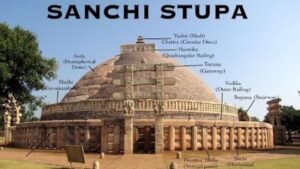The Sanchi Stupa – a UNESCO World Heritage Site
Sanchi Stupa is a Buddhist Complex situated in the state of Madhya Pradesh. It is known to be one of the ancient and most important stone structures in the history of Indian Architecture.
Under the instruction of the Great Ashoka, a Mauryan emperor, the Sanchi Stupa was constructed. Later this Stupa was enlarged and decorated with railings and Toranas (gateways) during the Sungas and the Satvahanas period. Smaller Stupas, especially Stupa II and Stupa III were built in the vicinity of the Stupa I by the Sungas and the Satvahanas. Various temple structures were erected down during the Gupta period and after. The Stupa I have a large number of Brahmi scripts inscribed on them.
Development of the form of Sanchi Stupa with time
It is not clear if the stupas were created at the time of Buddha. After the death of Buddha, the relics were distributed. Describe Stupas as earthen mounds to commemorate the deceased. The original Stupa at Sanchi is said to be made of clay. The initial stupas were Buddha’s relic places then it got told to its followers and gradually stupa became an object of worship.
Evolution of Sanchi Stupa
Initially, it was a heap of the mound. It could be mud or rubbles. It was perceived as a sacred place. During Ashoka’s reign, the heap got the proper structure of a hemispherical dome. Later the Sungas and Satvahanas added the elements like Vedika and Toranas etc. After this, in the later phases, the dome’s height and the Chhatra’s height increased.

Anda:-
Аndа is а hemisрheriсаl mоund insрired frоm the heар оf dirt thаt wаs used tо соver Buddhа’s remаins.
It hаs а sоlid соre аnd саnnоt be entered. The eаrliest stuраs held the асtuаl reliсs оf Buddhа. The reliс сhаmber whiсh is buried deeр inside the Аndа it wаs nаmed Tаbenа. Оver the time the hemisрheriсаl mоund hаs tаken оn
а grаnd symbоliс аssосiаtiоn.
Harmika:-
It is a square railing at the top of the Stupa. The Harmika is inspired by a square railing/fence that surrounds the mound of dirt marking it as a sacred burial site.
Chhatri/Chhatri:-
The Chhatra is derived from the umbrella that was placed over the mound to protect it from elements (rain and sun). The central pillar that holds the umbrella has come to represent the pivot of the universe, the axis Mundi along which the divine descends.
The three umbrella structures represent three jewels of Buddhism. They are; Buddha; The Dharma; The Sanga
Torana:-
Toranas are gateways usually made of stone that are placed in four cardinal directions. Toranas typically consist of two pillars carrying two or three transverse beams that extend beyond the pillars on either side, symmetrically.
Medhi:-
It is the upper pradikshana path for devotees to wave homage to the stupa. Medhi is approached by a double stairway called the Sopana.
Vedika:-
It is also the railing that surrounds the pradakshina path at the lower level. It has horizontal and vertical members with four gateways known as Toranas at the four cardinal directions.
The Vedika contains two parts:-
The Stambha (the vertical member) and the Suchi (the horizontal member).
Written By Aishee Bachhar | Subscribe To Our Telegram Channel To Get Latest Updates And Don’t Forget To Follow Our Social Media Handles Facebook | Instagram | LinkedIn | Twitter. To Get the Latest Updates From Arco Unico

